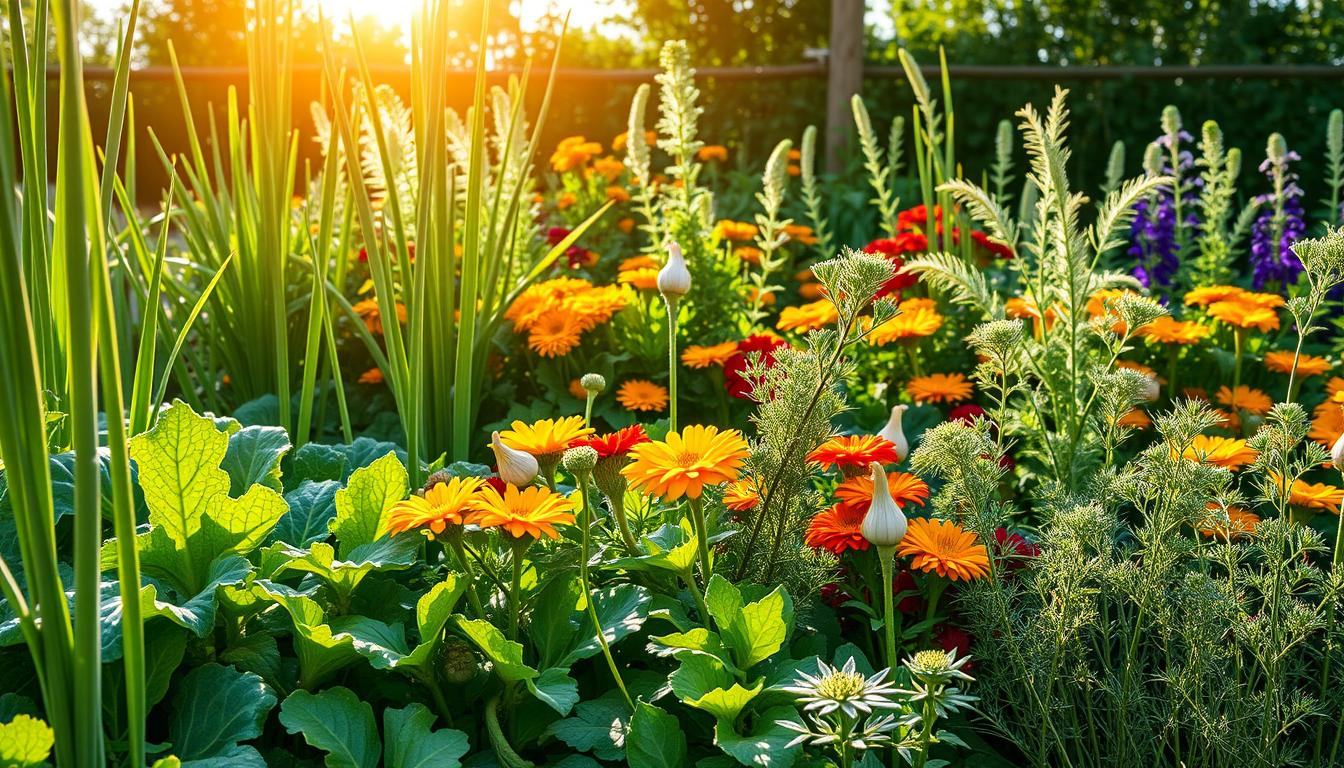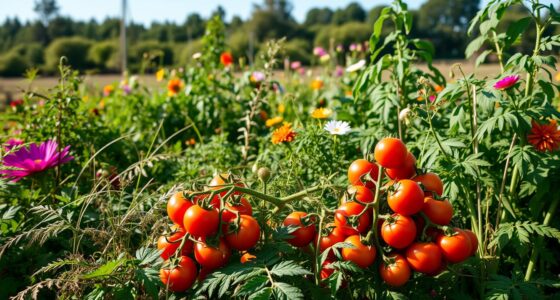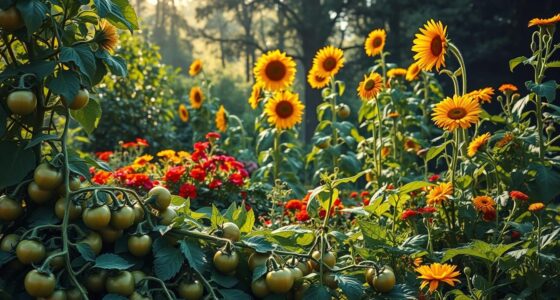Imagine stepping into your garden, the vibrant colors and rich aromas surrounding you, and among them, the unmistakable scent of fresh garlic. This beloved bulb isn’t just a culinary superstar; it’s a steadfast ally to your other plants. By choosing the right garlic companion plants, you can create a thriving ecosystem that elevates both your harvest and your gardening experience. Garlic’s natural pest deterrent properties not only protect your precious crops but also invite biodiversity into your garden. Whether you’re growing tomatoes, carrots, or luscious herbs, understanding the best plants to grow with garlic will transform your outdoor space into a flourishing sanctuary. Let’s dive into the art of companion planting and discover how garlic can bring your garden to life.
Key Takeaways
- Garlic is an excellent natural pest deterrent.
- Companion planting enhances biodiversity in your garden.
- Choosing the right companions boosts growth and flavor.
- Garlic plants thrive with a variety of vegetables and herbs.
- Understanding gardening partnerships leads to a bountiful harvest.
Understanding Garlic’s Growing Needs
To successfully grow garlic, it’s essential to understand its unique requirements. Many factors contribute to a thriving garlic plant, including the appropriate soil type, sunlight exposure, and watering techniques. By paying attention to these garlic growing needs, you can ensure robust development and flavorful bulbs.
Ideal Soil Conditions for Garlic
The ideal soil for garlic is loamy and well-drained, ideally with a pH level between 6.0 and 7.0. This type of soil allows for proper root development while preventing issues such as rot. Incorporating organic matter, like compost, can significantly improve soil quality and nutrient retention. Here’s a simple overview of soil types and their properties:
| Soil Type | Drainage | Nutrient Retention |
|---|---|---|
| Loamy | Excellent | High |
| Clay | Poor | Medium |
| Sandy | Good | Low |
Optimal Sunlight Requirements
For optimal growth, garlic requires plenty of sunlight and watering for garlic. Aim for at least 6-8 hours of direct sunlight each day. Adequate sunlight not only encourages growth but also enhances the flavor of the bulbs. Ensuring your garlic is placed in a sun-soaked spot can lead to a more robust harvest.
Watering and Drainage Tips
Watering practices play a crucial role in garlic cultivation. While garlic enjoys consistent moisture, it’s vital to maintain well-drained soil to mitigate the risk of bulb disease. A balanced approach to watering will promote strong growth—your goal should be to keep the soil evenly moist without waterlogging. Be mindful during dry spells, as insufficient moisture can hinder your garlic’s development.
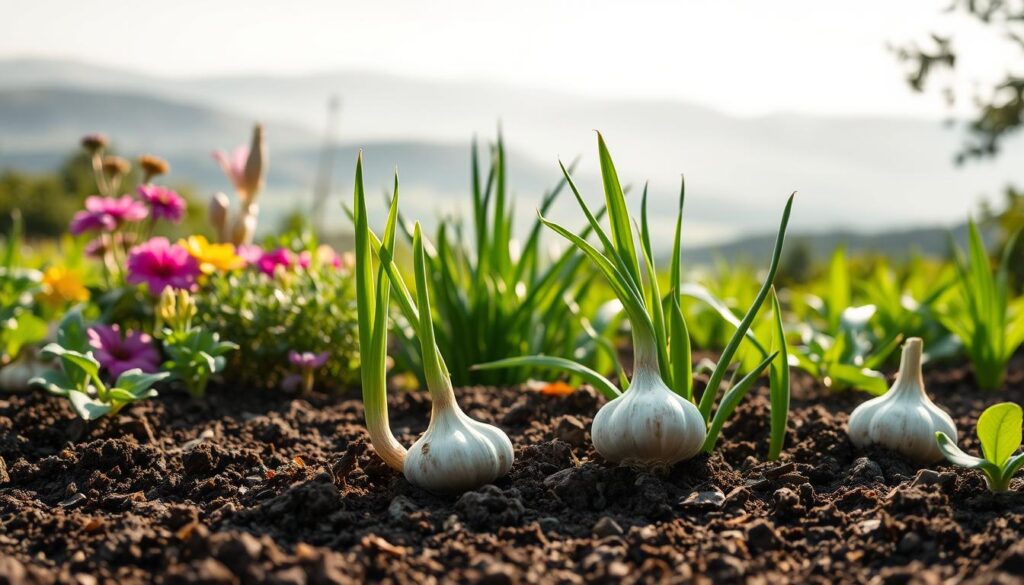
Benefits of Planting Companion Plants
Planting companion plants alongside garlic offers numerous advantages that can positively influence your gardening experience. Understanding these benefits can enhance your yields while improving the overall health of your garden.
Enhanced Growth and Flavor Profiles
Companion planting can significantly heighten the growth and flavor profiles of your garlic crops. When you grow garlic alongside certain plants, they can promote each other’s development, leading to healthier, more vigorous growth. You may notice that the flavor of your garlic improves, making it even more delightful in your culinary endeavors. The benefits of companion planting extend well beyond mere aesthetics, contributing to a rich and diverse harvest.
Pest Control and Natural Repellents
Garlic is renowned for its abilities as a deterrent for many pests, creating a natural repellent effect in your garden. By planting garlic with pest control plants, you can create an environment that significantly reduces the likelihood of infestations. This synergy offers important garlic companions benefits, allowing you to utilize nature to keep harmful insects at bay without the use of harsh chemicals.
Improved Soil Health and Nutrients
In addition to growth and pest management, companion plants can enhance soil health. Some plants contribute vital nutrients back into the ground, benefiting all associated crops. This boost in soil quality ensures that your garlic receives essential elements, promoting a robust harvest. In this way, the benefits of companion planting play a crucial role in creating a sustainable garden ecosystem.
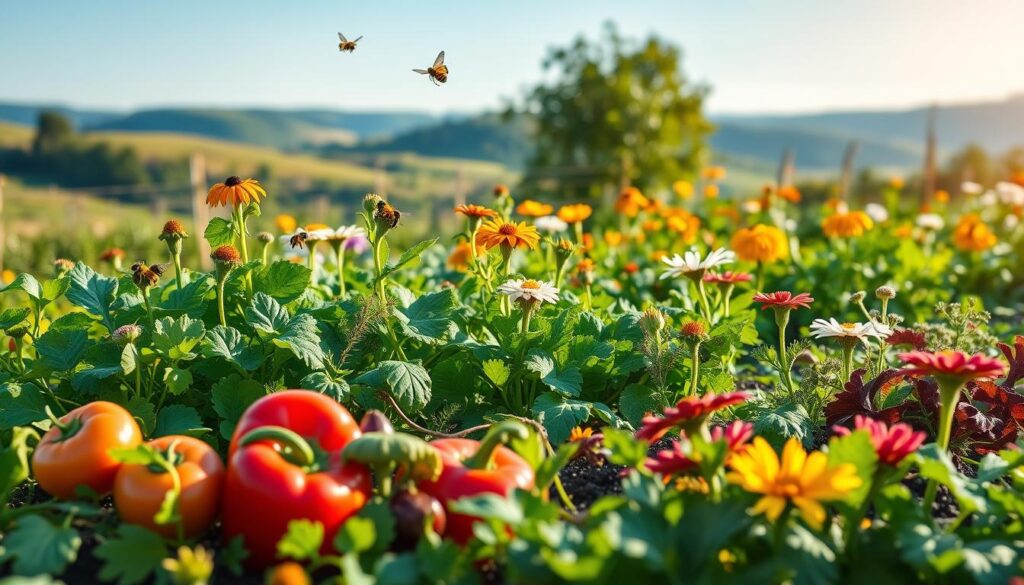
Top Companion Plants for Garlic
Garlic is not just a culinary staple; it also thrives when paired with certain companion plants. These top garlic companions can enhance growth while providing pest control and improving the overall health of your garden. Let’s explore some fantastic options for planting alongside garlic, including roses and garlic, carrots and garlic, and tomatoes with garlic.
Roses: A Beautiful Partnership
Many gardeners choose to plant roses and garlic together because garlic can deter pests that often prey on roses. The strong scent of garlic acts as a natural barrier, protecting the delicate blooms while enhancing the garden’s aesthetics. This partnership not only promotes healthier roses but can also boost their fragrance.
Carrots: A Root System Connection
When considering carrots and garlic, you’ll find they thrive together. Garlic’s growth can improve the soil structure, benefiting carrots as they develop below the surface. Additionally, the presence of garlic helps protect carrots from pests that may harm young plants.
Tomatoes: Flavor and Functionality
Tomatoes with garlic create a delightful pairing, as garlic helps enhance the flavor of tomatoes while also providing protection. The garlic’s aroma deters common pests such as aphids and whiteflies, which are known to bother tomato plants. This combination allows both plants to prosper and produce bountiful yields.
Peppers: Spicing Up Your Garden
If you’re seeking to spice things up, consider incorporating peppers alongside garlic. This partnership can enhance flavor profiles, allowing the two plants to support each other’s growth while keeping pests at bay. Garlic’s natural defense mechanisms create an ideal environment for growing robust peppers in your garden.

Herbs That Pair Well with Garlic
Integrating herbs that grow with garlic in your garden can significantly enhance the overall flavor and health of your plants. Among the popular choices, basil, chives, and oregano stand out as excellent companions. These herbs not only complement garlic’s robust taste but also work together to create a thriving garden ecosystem.
Basil: A Classic Combination
Basil and garlic create a well-known pairing in culinary dishes, making them a perfect match in the garden as well. When planted together, basil enhances the growth and flavor of garlic, yielding aromatic results. The fragrance of basil also helps to deter pests, providing an extra layer of protection for your crops.
Chives: Flavorful Allies
Chives pairing with garlic is another delightful combination. Both herbs enjoy similar soil and light conditions, making their cultivation straightforward. Chives contribute a mild onion flavor and can help ward off pests that may harm garlic bulbs. These flavorful allies promote healthy growth while adding variety to your garden’s herb palette.
Oregano: Perfect for Companion Planting
Oregano thrives in conditions akin to those preferred by garlic, making it an excellent choice for companion planting. This herb not only enhances culinary dishes but also acts as a natural insect repellent, helping to keep your garlic safe from unwanted pests. Introducing oregano into your garden can create a harmonious balance that benefits all plants involved.
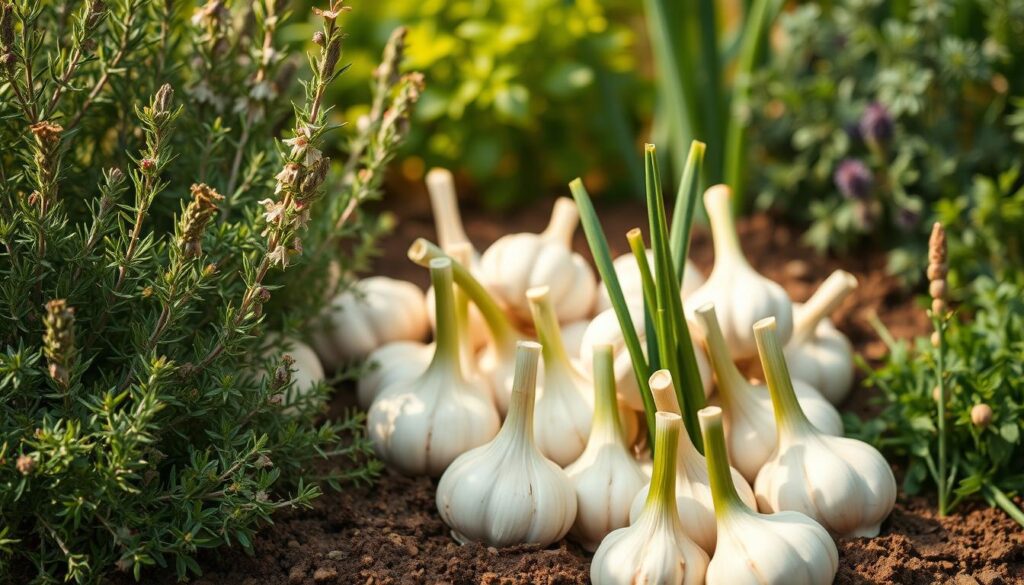
Vegetables That Thrive with Garlic
When considering the best vegetables to grow with garlic, you’ll discover that certain plants have a particular affinity for this pungent bulb. Onions and garlic are famously known as sisters in the garden due to their similar nutrient needs and growth habits. Beyond onions, other vegetables like spinach with garlic and lettuce can flourish alongside it, creating a harmonious and productive garden environment.
Onions: Sisters in the Garden
Onions and garlic exhibit a remarkable symbiotic relationship. Both belong to the allium family and enjoy similar growing conditions. Planting these vegetables together maximizes space and minimizes competition for nutrients. They help each other deter pests, providing a natural defense in your vegetable patch.
Spinach: A Nutrient-Rich Duo
Another excellent choice among the vegetables to grow with garlic is spinach. This leafy green thrives in the cool months of spring or fall, making it a quick-growing partner beside garlic. Spinach takes advantage of the light and moisture in the soil, effectively filling in any gaps between garlic plants.
Lettuce: Fast-Growing Companions
Lettuce can be an ideal companion for garlic, as it grows rapidly and appreciates the protective qualities garlic provides. This combination allows you to harvest lettuce quickly, ensuring a steady supply of fresh greens. As one of the fastest-growing crops, lettuce will fill your garden with vibrant colors and textures alongside your garlic plants.
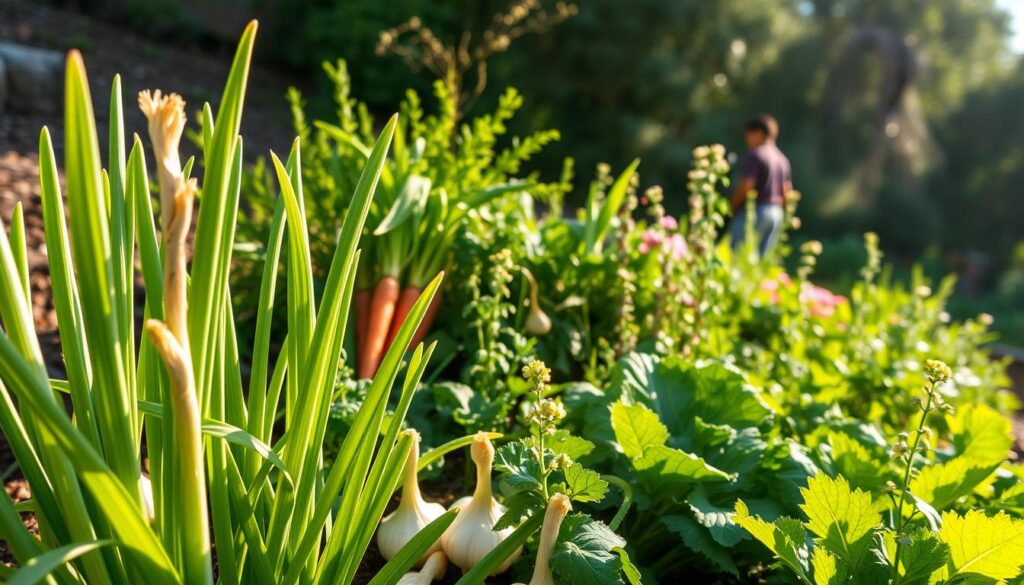
| Vegetable | Growth Characteristics | Benefits of Pairing with Garlic |
|---|---|---|
| Onions | Slow to mature; requires similar nutrients as garlic | Natural pest deterrent; shares soil space effectively |
| Spinach | Fast-growing; thrives in cooler weather | Efficient light use; fills gaps in planting |
| Lettuce | Very fast grower; abundant leaf production | Beneficial buddy; easy harvest alongside garlic |
Flowers That Support Garlic Growth
Integrating flowers that support garlic into your garden can elevate both aesthetics and functionality. These vibrant additions not only enhance visual appeal but also play significant roles in pest control, pollination, and nectar production. Below are three exceptional flowers that pair wonderfully with garlic, promoting a healthier garden ecosystem.
Marigolds: Natural Pest Deterrents
Marigolds are renowned for their ability to repel harmful insects, contributing to the marigolds garlic effect. By planting these colorful flowers near your garlic, you create a barrier against pests like aphids and nematodes. The strong scent of marigolds acts as a natural deterrent, keeping your garlic plants safe and thriving.
Nasturtiums: Edible and Beneficial
Nasturtiums with garlic offer dual benefits. These vibrant blooms are not only edible but also serve as a pest-repelling companion. Their leaves and flowers can be enjoyed in salads, while their presence can deter unwanted insects from your garlic plants. Incorporating nasturtiums enriches both your garden’s biodiversity and your culinary experiences.
Borage: Attracting Pollinators
Borage is another excellent addition, known for attracting beneficial pollinators such as bees and butterflies. This enhances the overall health of your garden. While borage does not directly impact garlic growth, its presence fosters a thriving ecosystem, encouraging increased pollination and ultimately leading to better yields from your garlic crop.
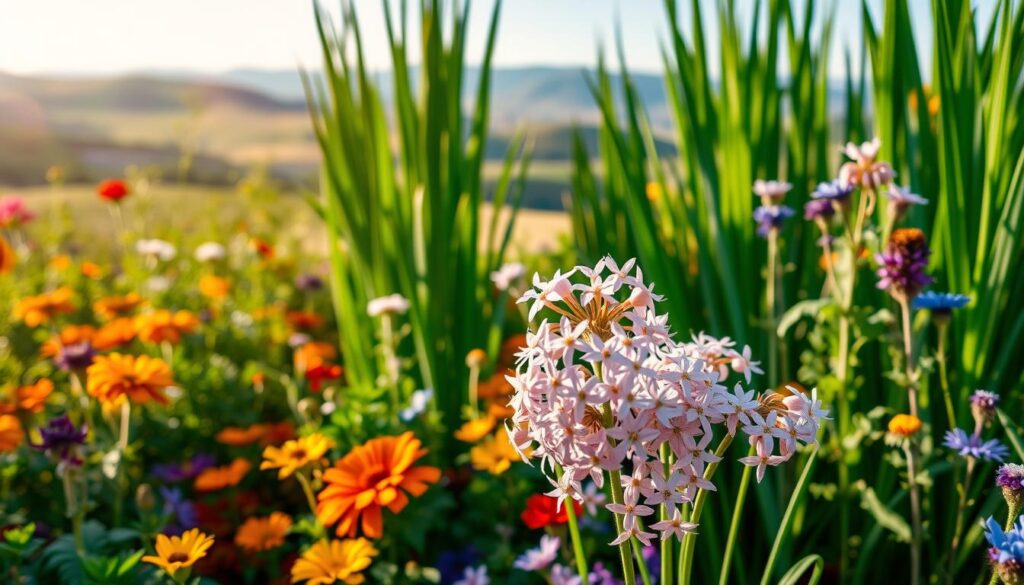
What to Avoid Planting with Garlic
When planning your garden, it’s crucial to be aware of the plants to avoid with garlic. Some plants simply do not thrive when grown alongside garlic, leading to garlic companion conflicts. Understanding these incompatible plants can help you maximize your garden’s productivity and health.
Brassicas: Cabbage Family Conflicts
Brassicas, such as cabbage and broccoli, often compete for similar nutrients, making them unsuitable companions for garlic. Their overlapping needs can hinder the growth of both types, and planting them together can result in weaker plants and reduced yields.
Legumes: Competing Needs
Legumes, including beans and peas, face challenges when planted near garlic. The compounds released by garlic can stunt the growth of these plants, creating unfavorable conditions. If you want to ensure a thriving legume crop, it’s wise to keep them away from garlic.
Asparagus: Poor Companionship
Asparagus represents another example of a plant that does not get along with garlic. The presence of garlic can negatively impact asparagus growth, resulting in compromised harvests. Maintaining distance between these two plants can contribute to a healthier garden.
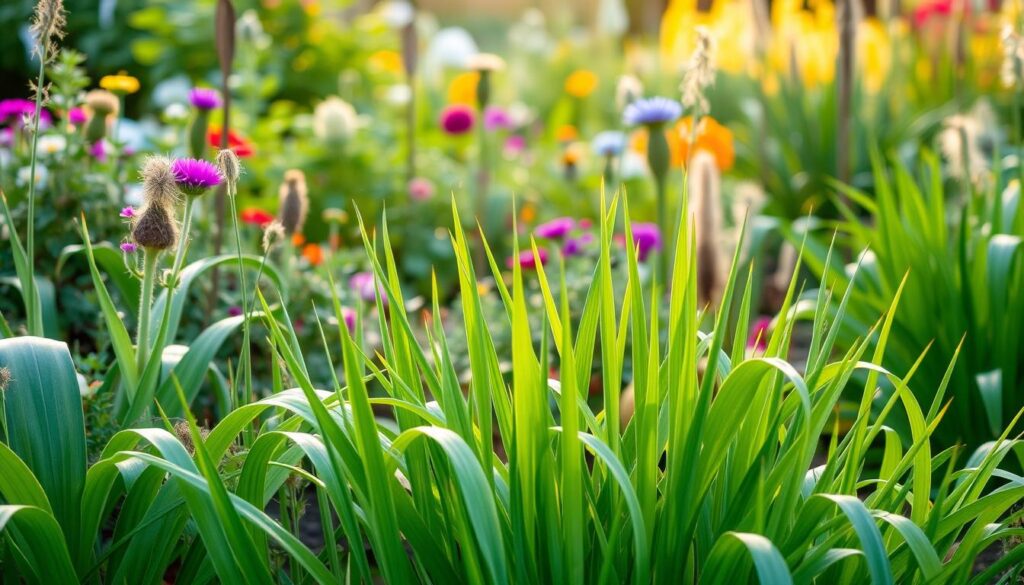
| Plant Type | Reason for Incompatibility |
|---|---|
| Brassicas (Cabbage, Broccoli) | Compete for nutrients, leading to reduced growth. |
| Legumes (Beans, Peas) | Garlic’s compounds stunt their growth. |
| Asparagus | Garlic negatively impacts asparagus growth. |
Planting Strategies for Companion Gardening
When it comes to achieving a flourishing garden, effective planting strategies for garlic play a crucial role. Utilizing techniques like crop rotation with garlic and interplanting garlic with compatible companions can significantly enhance plant health, maximize space, and promote diverse ecosystems. Implementing these strategies leads to improved yields and a more resilient garden.
Crop Rotation Benefits
Implementing crop rotation with garlic helps maintain soil fertility and reduce pest pressures. By alternating the types of crops grown in a specific area, you can minimize disease buildup and nutrient depletion. Garlic, when rotated with other crops such as legumes or grains, contributes to better soil structure and promotes healthier root systems.
Interplanting Techniques
Interplanting garlic alongside companion plants is a dynamic method to maximize your garden’s potential. This strategy allows you to use available space efficiently while creating a more biodiverse environment. Choosing compatible plants for interplanting garlic can deter pests naturally, enhance flavors, and facilitate optimal growing conditions.
Spacing and Placement Tips
Proper spacing and placement of garlic and its companions are essential for healthy growth. Ensure adequate distance between plants to promote airflow and reduce competition for nutrients. Generally, garlic should be planted 4-6 inches apart, allowing companions to flourish without overcrowding. Thoughtful placement enhances both growth rates and yields for all your plants.
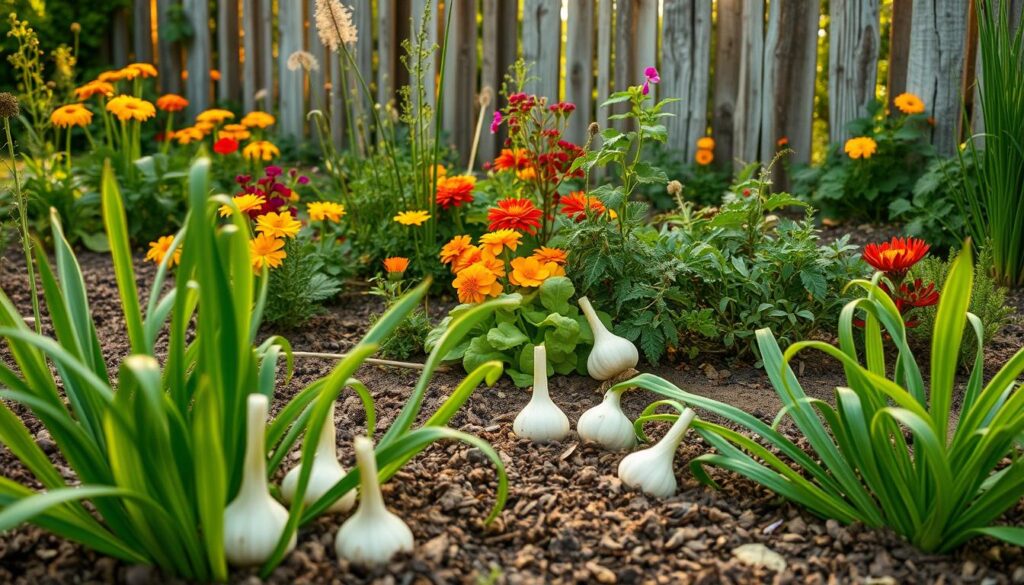
Timing Your Companion Planting
Understanding the right timing for planting garlic and its companions can significantly impact your gardening success. Garlic planting timing is essential for achieving healthy crops and optimal yields. Knowing when to plant garlic not only sets the stage for its growth but also affects the compatibility with other plants in your garden. Proper timing aligns with seasonal planting considerations that help create a flourishing garden ecosystem.
Best Times to Plant Garlic
The ideal time to plant garlic is in the fall. This allows the garlic to establish roots before the onset of winter, providing a strong foundation for the following spring’s growth. Some gardeners choose to plant in the spring for mid-year harvests. Regardless of your choice, pay attention to local climate conditions to optimize your garlic planting timing.
Coordinating with Companion Plant Schedules
To maximize the benefits of your garden, familiarize yourself with the companion planting schedules of your chosen plants. Each plant has specific growth rates and harvest timelines. Coordinating these schedules will help ensure that your companions grow harmoniously alongside garlic, allowing for better use of space and resources.
Seasonal Considerations for Your Garden
Seasonal planting considerations play a vital role in the health and productivity of your garden. Different plants thrive in varying conditions throughout the year. Be mindful of temperature fluctuations, rainfall, and sunlight availability to create an environment where both garlic and its companions can flourish together.
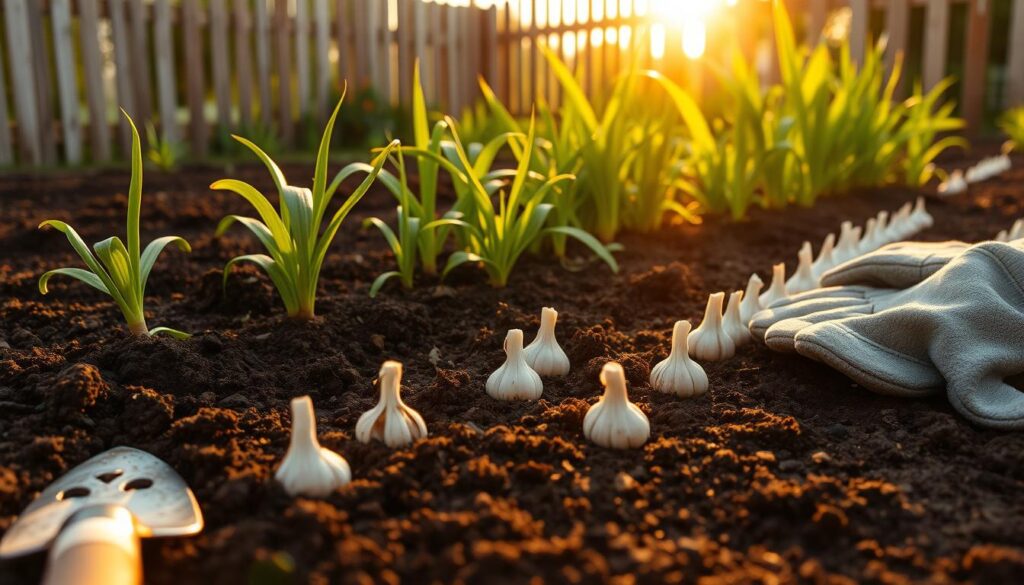
Maintaining Your Garlic and Companions
Successful garlic maintenance requires attention to various factors, including watering, fertilization, and weeding. Proper care ensures that garlic plants and their companions thrive together in your garden.
Regular Watering Practices
Watering garlic plants consistently is vital, especially during dry periods. Aim to keep the soil evenly moist, as this promotes healthy growth. Avoid overwatering, which can lead to root rot and other issues. A good practice is to check the soil moisture regularly, ensuring it feels slightly damp but not soggy.
Fertilization Tips for Success
Garlic fertilization plays a crucial role in enhancing plant health and yields. Applying organic compost provides essential nutrients that support both garlic and its companion plants. A balanced approach to fertilization helps maintain healthy soil, ensuring that the plants receive the nourishment they require for optimal growth.
Pruning and Weeding Strategies
Regular pruning of garlic plants can improve air circulation and reduce disease risk. Removing excess foliage allows energy to be directed toward bulb development. Weeding is equally important; keeping the garden free from weeds ensures that garlic and its companions get the nutrients they need without competition, which is essential for successful gardening.
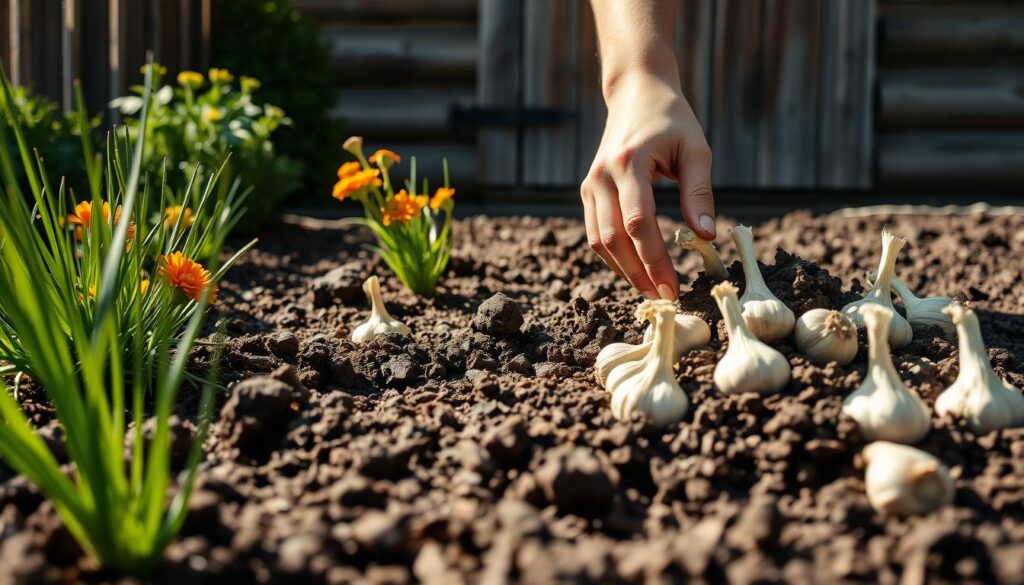
Harvesting Garlic and Companion Plants
As your gardening season approaches its peak, it’s essential to know when and how to begin harvesting garlic and its companions effectively. Recognizing garlic readiness signs can make all the difference in ensuring a high-quality yield. Planning your harvest allows you to optimize flavor and enhance the overall experience.
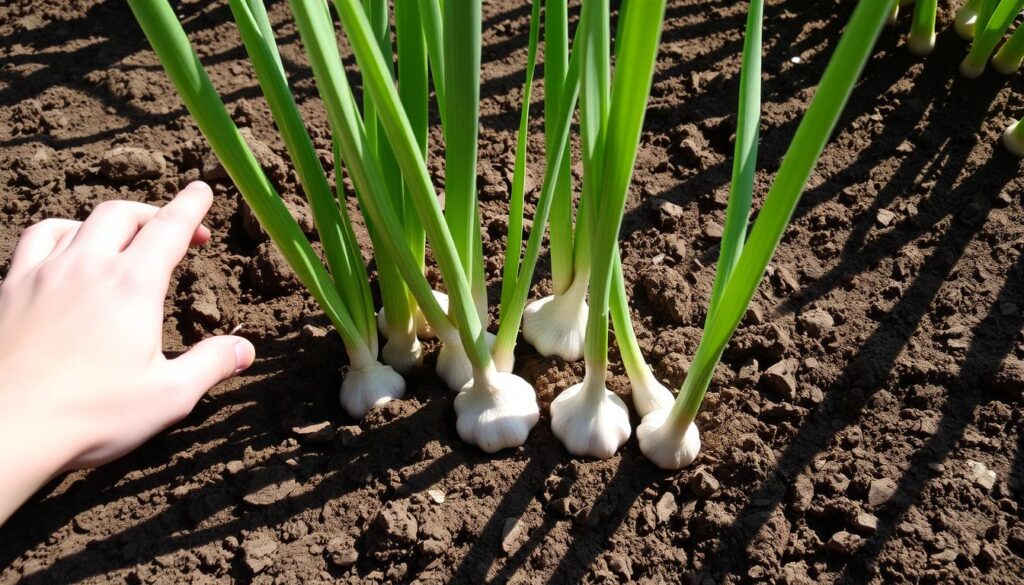
Signs of Garlic Readiness
Garlic indicates its readiness through several key signs. Look for the lower leaves turning brown while a few green tops remain. This combination suggests that bulbs have matured. Waiting too long can lead to splitting, impacting storage quality. Checking the size of the bulbs can give you additional assurance. They should feel firm and well-rounded when ready for harvesting.
Timing Your Harvest for Best Flavor
Timing plays a critical role in achieving the best flavor from your garlic. Ideally, aim to harvest in midsummer, as this is when bulbs reach their peak. Consider establishing a schedule that correlates with your companions to keep everything organized. This coordination can enhance the overall flavor profile of your dishes and provide a sense of accomplishment in your gardening journey.
Gathering Companions: A Team Effort
As you prepare to harvest garlic, gather your companions simultaneously to streamline the process. This approach prevents the premature wilting of tender herbs and vegetables. Organizing your harvest allows you to enjoy the fruits of your labor more efficiently. Teamwork among your plants encourages a healthier garden and creates a joyful atmosphere during your harvesting season.
Storing Garlic and Its Companions
Successfully storing garlic and its companions ensures that you can enjoy their flavor long after harvest. Familiarizing yourself with various garlic storage methods will preserve the quality and freshness of your bounty. This section delves into the best practices for storing garlic and preserving companions like herbs and vegetables.
Best Methods for Garlic Storage
When it comes to garlic, selecting the right storage technique is crucial. The ideal conditions involve keeping garlic in a cool, dark, and dry area. Hanging braids create airflow that prevents moisture buildup. Consider placing garlic bulbs in mesh bags or baskets to promote air circulation.
Preserving Companion Herbs and Vegetables
For companion herbs, you have options for preserving freshness. Drying herbs allows you to retain their flavor and aroma. Alternatively, freezing them is an excellent choice, particularly for larger quantities. When preserving companions, methods like blanching before freezing prevent loss of taste and texture.
Tips for Long-Term Storage Solutions
Implementing effective long-term storage tips ensures your garlic and companion plants remain flavorful. Always monitor storage conditions for humidity and temperature. Regular checks on the stored items can help spot any spoilage early. Investing in airtight containers can further extend the shelf life of your preserved companions, keeping them ready for your culinary needs.

Adding Garlic Companions in Urban Gardens
Urban gardening with garlic can be a rewarding experience, allowing you to enjoy fresh flavors right from your own home. Adopting container gardening and vertical gardening tips can create a thriving ecosystem in even the smallest spaces.
Container Gardening Success
Container gardening offers fantastic benefits, such as improved soil control and mobility. You can easily manage your garlic and its companions by choosing suitable pots. Consider using a mix of herbs like basil or chives alongside your garlic for optimal growth and flavor. The combination not only enhances your culinary endeavors but also allows for easy access to fresh ingredients.
Vertical Gardening Techniques
Utilizing vertical gardening techniques maximizes your space by growing plants upwards rather than outwards. This method allows garlic to flourish alongside climbing plants such as beans or peas. Incorporating vertical structures like trellises can also provide necessary support while encouraging air circulation, essential for healthy plants.
Space-Saving Strategies for Small Areas
When you have limited space, implementing clever strategies is crucial to a successful urban garden. Planting garlic in layers or utilizing wall planters can help you make the most of your available area. Grouping plants with similar sunlight and watering needs will simplify care and maximize the output from your urban gardening with garlic efforts.
| Strategy | Benefits |
|---|---|
| Container Gardening | Better soil control and mobility |
| Vertical Gardening | Maximizes space and improves air circulation |
| Layered Planting | Efficient use of space and resources |
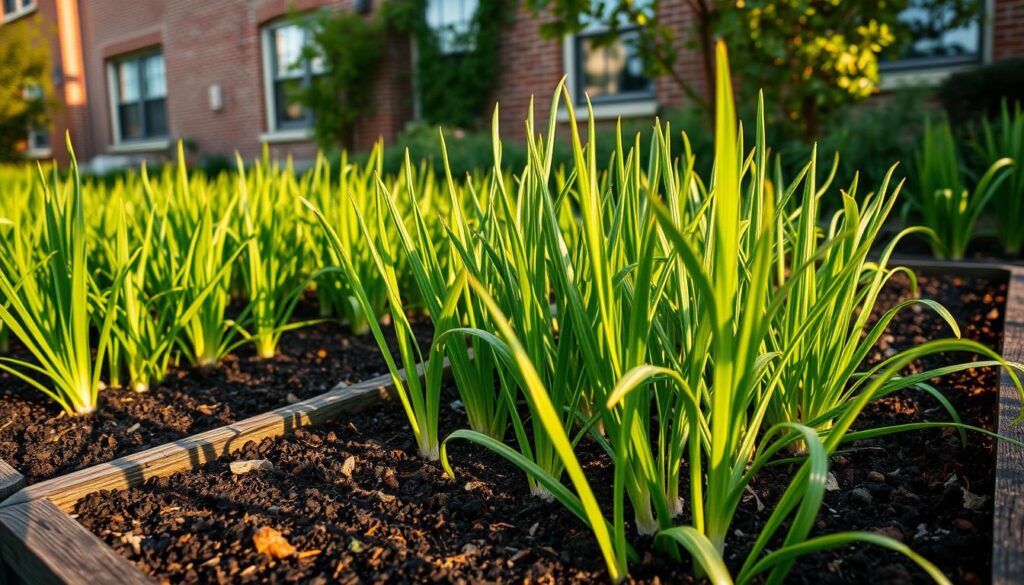
Success Stories in Companion Planting
Many gardeners have discovered remarkable transformations in their gardens through effective companion planting, especially with garlic. The widespread adoption of this method has led to numerous companion planting success stories highlighting the remarkable benefits that aid both novice and experienced gardeners.
Testimonials from Experienced Gardeners
Gardeners across the country share enthusiastic gardener testimonials about their experiences with companion planting. They often describe how pairing garlic with companion plants has resulted in noteworthy flavor enhancements and healthier produce. For instance, one gardener noted the difference in taste when tomatoes grown alongside garlic were harvested, while another shared the effective pest control achieved by introducing marigolds. These accounts reveal a strong belief in the transformative effects of companion planting.
Case Studies: Transforming Yields
Numerous case studies document the yield transformation that occurs when garlic is paired with the right companion plants. Reports indicate significant increases in crop yields, especially when garlic is combined with crops like carrots and peppers. These studies demonstrate how collaborative planting can lead to a thriving ecosystem in the garden, ultimately benefiting all the plants involved.
Overcoming Challenges Together
Many gardeners face challenges such as pests, diseases, and nutrient deficiencies. Collaborating with garlic as a companion can make overcoming these obstacles easier. Growers frequently report that garlic wards off pests, making it a crucial ally in their gardens. The shared experiences of these gardeners serve as a testament to the effectiveness of combining efforts in companion planting, yielding solutions that enhance overall garden productivity.
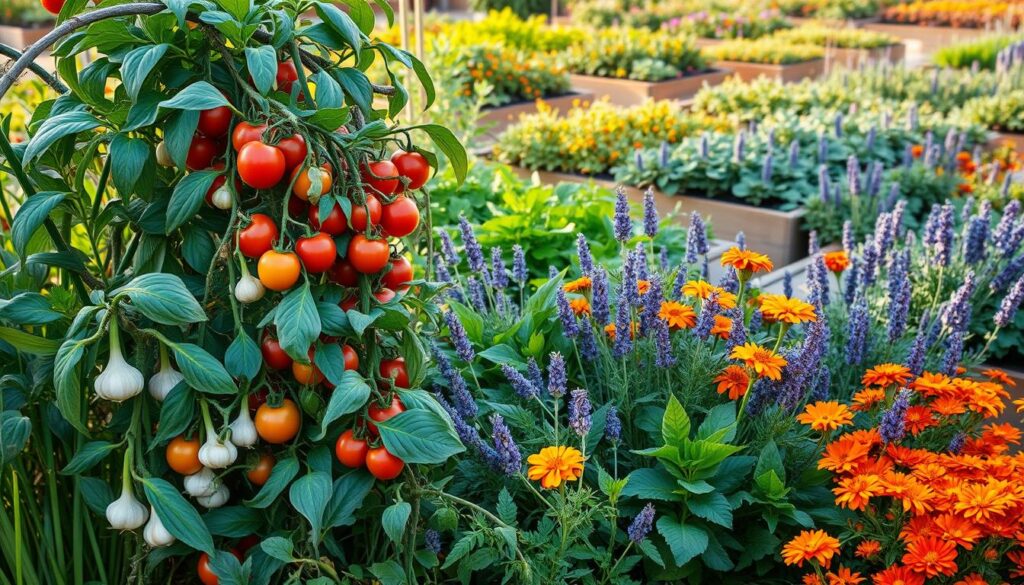
Getting the Most Out of Your Garden
Maximizing garden yield involves a thoughtful approach to combining different plants. Exploring various combinations allows you to discover which plants thrive together in your unique garden environment. This experimentation can lead to a more productive and vibrant garden.
Experimenting with Different Combinations
Experimentation is key when aiming for the best results. Consider pairing plants that have complementary growth habits. Observe how your garlic interacts with its companions. This can reveal surprising benefits and enhance the overall health of your garden.
Keeping a Gardening Journal
Utilizing gardening journal tips can significantly improve your gardening experience. Document your planting dates, weather conditions, and the successes or failures of various plant pairings. This record will serve as an invaluable resource, guiding you in making informed decisions in future gardening endeavors.
Continuous Learning and Improvement
Learning gardening is an ongoing journey. Staying informed about new techniques and trends in companion planting will bolster your gardening skills. Engaging with the gardening community and seeking resources can provide fresh insights and foster a culture of continuous improvement.
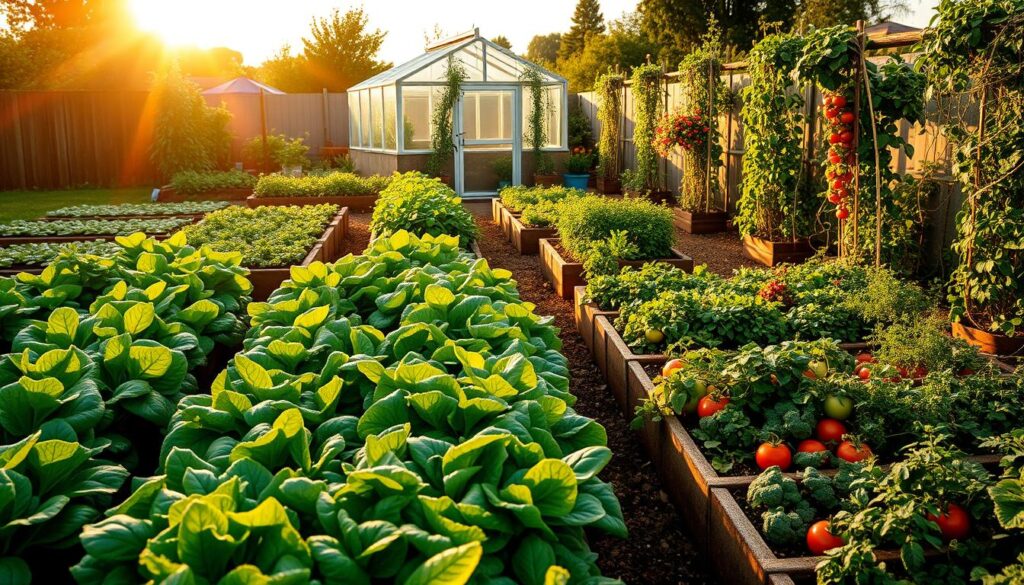
Resources for Garlic Companion Planting
Expanding your knowledge on garlic companion planting can truly enhance your gardening experience. A variety of garlic companion planting resources are available to help you grow a vibrant and productive garden. From gardening books to online communities, there are plenty of options to explore. Participating in local workshops can provide hands-on experience and connect you with like-minded gardening enthusiasts.
Recommended Books and Guides
Numerous gardening books focus on the benefits of companion planting, especially with garlic. These resources often provide detailed information on plant pairings, garden layouts, and strategies for pest management. Investing time in reading these guides can offer you invaluable insights to improve your gardening techniques.
Online Communities and Forums
Joining online communities dedicated to gardening can foster an exchange of knowledge and experiences. Many forums feature discussions about garlic companion planting resources, allowing you to ask questions, share your successes, and learn from the challenges faced by others. Engaging in these platforms can significantly broaden your understanding of best practices.
Local Gardening Clubs and Workshops
Finding local gardening clubs and workshops can enhance your practical skills. These gatherings often provide opportunities for hands-on learning, where you can practice techniques with experienced gardeners. In addition to workshops, clubs frequently share valuable resources surrounding garlic companion planting, making them a great way to dive deeper into the subject and meet fellow gardening enthusiasts.

Final Thoughts on Garlic Companion Planting
As you wrap up your journey into the world of garlic companion planting, it’s essential to recognize that this method is about much more than just cultivating vegetables. Embracing the art of companion gardening involves creating a synergy of plants that not only thrive together but also enhance each other’s growth. It transforms your outdoor space into a haven of biodiversity, where the benefits extend beyond individual yield.
The joy of gardening is amplified when shared. By encouraging others to garden, you foster a sense of community, where knowledge and experiences can flow freely. The stories and successes you share can inspire fellow gardeners to explore companion planting, leading to a more vibrant and supportive atmosphere in your neighborhood. Every interaction can strengthen your gardening network and create memorable partnerships.
Remember, each garden represents a unique experiment filled with possibilities. As you share your insights and discoveries from your own companion planting trials, you contribute to a culture of continuous learning and improvement. Your enthusiasm can motivate others to join you in this fulfilling endeavor, enhancing their gardening experiences while also celebrating the rich connection we all share with nature.
